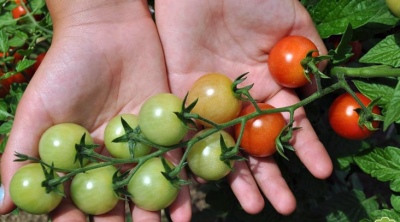
- Authors: Postnikova O.V.
- Year of approval: 2017
- Category: grade
- Growth type: indeterminate
- Appointment: universal
- Ripening period: mid-season
- Ripening time, days: 90-95
- Growing conditions: for open ground, for film greenhouses, for closed ground, for greenhouses, decorative landscaping
- Bush size: tall
- Bush height, cm: up to 200
Breeders from the Novosibirsk agricultural firm have bred the Bull Eye variety. It was entered into the Russian State Register in 2016. Since then, they began to cultivate it both in open areas and in film greenhouses.
Description of the variety
A universal fruit crop is grown in open and closed ground, as well as in various types of greenhouses. Growth is indeterminate. Tall plants reach two meters (in open areas). In shelters, growth is practically unlimited. The length of the leaves is medium, the color is light green. Shoots are soft, light green. In the process of growth, they gradually grow stiff.
The first fruit cluster is laid over 7 or 8 leaves, and the next ones - every 2 leaves. On the first pair of brushes, from 10 to 12 tomatoes ripen at the same time, and the rest are able to withstand from 30 to 40 pieces. The flowers are large and they bloom consistently.
The main qualities of the fruit
Unripe tomatoes have a green spot at the base. The standard color is light green. Ripe vegetables turn bright red. Size - small, typical of cherry tomatoes. Weight - 10 grams. The shape is round, there is a slight ribbing. The inflorescences are complex. The skin is shiny, under which the dense pulp is hidden, and quite juicy. When cut, 2 seed chambers can be found.
Due to their neat appearance and small size, tomatoes are used to decorate various dishes: meat, salads, snacks. They are cut into halves or left whole. The Bullseye crop is perfect for drying. Vegetables are harvested using ovens, electric dryers and other equipment.
Taste characteristics
The taste of tomatoes is pleasant, sweet and harmonious. The peel is very tender and does not cause discomfort when eaten. The percentage of sugar content is more than 4.5. Due to their special gastronomic qualities, tomatoes are added not only to vegetable salads, but even to berry and fruit salads.
Ripening and fruiting
The bull's eye belongs to the mid-season varieties, the ripening period of which is from 90 to 95 days. It is grown in different regions of the country. Experienced gardeners recommend cultivating the vegetable indoors.
Yield
The high yield of the variety allows you to collect up to 8 kilograms of fruit in open areas and 10-12 kilograms in greenhouses.
The timing of planting seedlings and planting in the ground
The exact timing depends on the climate in the area and the cultivation method. Breeders advise to sow 45-50 days before transplanting seedlings. If heating is not provided in the greenhouse, tomatoes should be planted as soon as the average daily temperature is at least +12 degrees. Landing in open ground is performed as soon as the frost has completely passed, and even after sunset the temperature does not drop below +10 degrees.

Growing tomato seedlings is an extremely important process, because it largely depends on whether the gardener can harvest at all. All aspects must be taken into account, from seedbed preparation to planting in the ground.
Landing scheme
3 bushes are grown within one square meter. So the plants will not interfere with each other.

Growing and caring
Agrotechnology necessarily includes shaping, garter and pinching. When forming, leave 1-2 stems. To obtain a rich harvest, the Bullseye variety should be grown on nutritious soils. In the process of formation, the plant takes up a lot of nutrients. Light to medium loamy soil is ideal.
If the soil is heavy, it is advisable to prepare it in advance. Sawdust, humus and sand are introduced. Depleted soils are fed with a large amount of organic matter, compost and humus. It is also recommended to prepare wells in advance. Before transplanting, they are treated with a weak solution of potassium permanganate and treated with ash. The earth lump is not destroyed, but transplanted together with it. After transplanting, the soil is carefully tamped. After that, abundant irrigation is performed in several stages.
The technique of watering small tomatoes differs from the stationary one. The variety does not tolerate drought and excess moisture. The bushes are irrigated about once every 2-3 days, avoiding stagnation of the liquid. Use warm and settled water. The soil around the plants is covered with a layer of mulch so that a dry crust does not form on the surface of the soil. The top layer is loosened regularly. Mulch can be both natural and synthetic materials.
Mulch made from straw, compost, dry grass (no seeds) or compost has proven to be excellent. It not only protects the soil from drying out, but also nourishes the site. Some gardeners use old newspapers.
The plantation is fertilized every 14 days, starting 10-15 days after transplantation to a permanent cultivation site. They use both folk remedies and complex formulations, which can be purchased in specialized stores. To achieve maximum results, feeding is alternated.
Bushes need nitrogen for active growth. Potassium is added to form buds and stems. Phosphorus has a positive effect on the condition of the root system and fruits.




A plant needs different micronutrients at each stage of growth. All fertilizers can be divided into two groups: mineral and organic. Folk remedies are often used: iodine, yeast, bird droppings, eggshells.
It is important to observe the rate and period of feeding. This also applies to folk remedies and organic fertilizers.
Disease and pest resistance
To preserve the plantation and harvest, it is necessary to periodically carry out preventive treatment against diseases and pests. The use of ready-made preparations will help save time, but some summer residents trust folk remedies more.



























































































